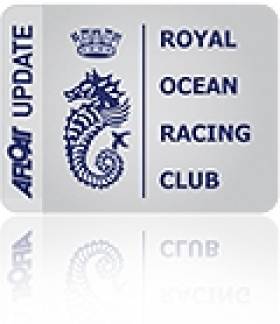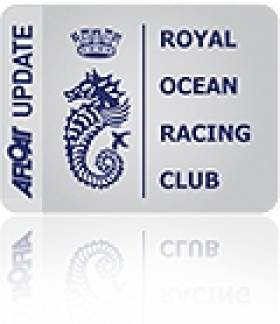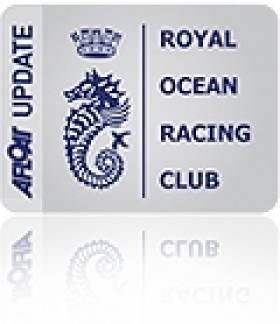Displaying items by tag: Easter Challenge
RORC Easter Challenge IRC Fleet Building Nicely
#rorc – The RORC Easter Challenge, which offers a unique training ground for owners and crews over a three-day inshore regatta starts on Good Friday. A new initiative for 2014 is the North U. Regatta Service that will enhance what is already a popular and unique coaching event in the UK.
"It will be a great service to the boats who want to improve their all-round performance ready for a full race season," says RORC Racing Manager, Nick Elliott.
Coaching guru, Jim Saltonstall's inimitable on-the-water tuition and post-race video debriefs will be augmented by the North U. Regatta Service team from the USA, who will be providing coaching and performance analysis tailored to sail trim and speed.
"The fleet for the RORC Easter Challenge is looking good," adds Elliott. "As well as being joined by regular RORC competitors and boats from France, The Netherlands and as far as Hong Kong, we are also seeing potential candidates interested in the RYA Selection Trials for this summer's Brewin Dolphin Commodores' Cup. They'll be a competitive fleet on the start line in Cowes, fighting it out for Easter eggs and prizes."
The RORC Easter Challenge is open to Spinlock IRC rated yachts and the entry fee includes pre-race weather related informal chats, on-the-water coaching and post-race debrief sessions in Cowes.
Light Solent Winds Keep O'Leary and Dowling at Bay
RORC Easter Sailing Challenge – Day 2 Light winds are keeping Irish entries in the bottom half of the respective IRC fleets at RORC's Easter challenge this weekend. After four races sailed, Royal Cork's Anthony O'Leary lies sixth from ten boats in the IRC 1 division. In IRC 2 Dun Laoghaire's Niall Dowling sailing a brand new J111 also lies sixth from ten. James Boyd reports from the Solent: With a forecast indicating no wind on the Solent, the race committee and competitors were blessed in being able to get two races in on the second day of the RORC Easter Challenge, once again held in unseasonably summer-like conditions.
While the first start was scheduled for 1000, a windless Solent saw racing postponed for three hours. Competitors were kept occupied in the Cowes Yacht Haven Events Centre with a valuable talk from Jim Saltonstall on race preparation.
Early afternoon the race committee made the brave call to get underway on a course off Hill Head despite the apparent mill pond. In fact there was wind off the water and a meaningful race was held. As women's match racer Josie Gibson, helming the new Mat 1010 in IRC 3, observed: "It was really good of them to try and do it, because the alternative was to wait for the new breeze. It wasn't totally unfair but it was just very very light. There was an awful lot of shear. At the top we were getting 5-6 knots but it was really glassy on the water."
At the end of the first race the wind began to veer into the southwest as the sea breeze prevailed and for race two, the wind picked up to an unexpected 13-14 knots with the tide running left to right across the course on the beat. From the first race, where crews were being sat down to leeward, for race two they were up on the weather rail, fully hiking.
At the end of play, in IRC1 Mike Bartholomew's King 40 Tokoloshe now shares the top spot with Rob Gray and Sam Laidlaw's Farr 50, Bob, the biggest boat in the RORC Easter Challenge fleet.
"Sam sailed the first race and we got away quite nicely. She goes like a rocketship in the light stuff," recounted Gray of his Farr 50 which is looking very smart with a new paint job and, for this season, a stiffer mast, new mainsail and an enlarged asymmetric kite. "We were sailing faster than the apparent wind. Tokoloshe is sailing very very well. In the second race today she was way to the right and was first to catch the new breeze." The two boats share the top spot due to Tokoloshe posting a fourth in today's light opener.
In IRC Two, frustrating Andrew McIrvine in his second placed First 40 La Réponse, Andrew Williams' Prima 38 Max 'Ed Out! holds the lead having won both today's races, putting them two points ahead of the RORC Commodore. Williams and his crew have made the trip up from Plymouth to compete. For this season they have changed the name of their boat from Mighty Max III after they enlarged the size of their biggest spinnaker by 35%.
"This is the first time we have raced her with the new rating and it has made a tremendous difference," said Williams. In today's ultra-light first race Williams said it was all about keeping the boat moving. "She is a 14 year old design and we have had three firsts and a fourth, which for a scratch crew with a boat with a new sail configuration we've only been out once with - we feel quite pleased with the way she is performing."
Chris and Hannah Neve's high experienced crew on the Lymington-based First 35 No Chance are slipping away in first place in IRC 3 after posting a 2-1 today. They lead Louise Morton's Mat 1010 by three points. The RORC Easter Challenge is only Mat 1010's second competitive outing. The boat is being sailed by Morton's all-female crew that normally race on the Quarter Tonner Espada, with the exception of Volvo Ocean Race winning navigator Jules Salter, taking time off from his latest campaign with Abu Dhabi Ocean Racing. "This morning was quite like Abu Dhabi," quipped helm Josie Gibson.
IRC4 is the only class to have a run-away leader in Grant Gordon's J/97 Fever, now nine points clear of Paul Blowers and Nick Daniels Impala Patriot Games, while in the J/80s Kevin Sproul made a good come back after yesterday's rig issues to win both today's races.
Despite the light wind to start with today, the conditions once again proved ideal for the on-the-water coaching provided by Jim Saltonstall, Barry Dunning and their team. The RORC Easter Challenge is a 'coaching regatta' and the competitors have been lapping up the advice during races as well as the post-race video analysis ashore.
"Today was brilliant because you could concentrate on sail shapes and not get too distracted. At least you aren't battling around in survival conditions like you normally are," commented Ben Jones, the main trimmer on Mike Greville's Erivale of today's coaching. "It is always nice to have a view from outside of the boat and there are some good people there telling you gently and sensitivity that you've got it slightly wrong. We have suffered from a bit of pressure. It is very useful."
"It is really good to have it," agreed Louise Morton of the coaching. "We enjoy going to the briefings and seeing on video how far forward we are for the starts or not. You pick up one or two things every time. Just things like trim and whether we should be sitting further forward on the boat. Jim is very incite-full."
A further two races are scheduled to start at 1000 tomorrow, the final day of racing at the RORC Easter Challenge with a forecast similar to today's.
For more information, visit the RORC web site: www.rorc.org
Dowling's New J111 to Contest Easter Challenge
The brand new J/111 Arabella, belonging to Dun Laoghaire's Niall Dowling joins Royal Cork's Anthony O'Leary sailing Antix for this weekend's season opener on the Solent for the Royal Ocean Racing Club's Easter Challenge.
Summer looks set to come early as the RORC 2011 sailing season opener gets underway on the Solent this Friday with the first races of the club's annual RORC Easter Challenge and mostly sunny weather and light to moderate winds forecast. Racing is set to take place over three days, concluding on Easter Sunday.
The RORC Easter Challenge stands alone in the club's calendar as aside from enabling competitors to brush the cobwebs off after the winter break, it is also set up as a training regatta complete with on the water coaching.
"It is unique, because while it is a proper regatta and people take it seriously, they want to win it, we change the rules to allow outside assistance," says RORC CEO, Eddie Warden Owen. "So it is a training regatta, with an opportunity to be coached while racing."
Among the coaches will be Warden-Owen, Jim Saltonstall, Barry Dunning along with representatives from several leading sailmakers. They will be following the fleet in RIBs and the rule change allows them to jump on board boats, or take crew off boats to demonstrate what they could be doing better. The J/80s taking part will have their own specialist coach.
At the time of writing the entry stood at 61 boats, which Warden Owen says he is satisfied with given the Easter break is unusual this year with the royal wedding taking place the following weekend, and many expected to be taking the entire week off.
Late entries among the 61 include RORC Vice Commodore Mike Greville and his newly re-keeled Ker 39, Erivale III and Rolex Commodores' Cup competitors Chris and Hannah Neve on their First 35, No Chance.
While Rob Gray and Sam Laidlaw's Farr 52, Bob is the lone entry in Class Zero, the competition is looking good in Class 1, where in addition to Erivale III, the line-up features Irish 2010 Rolex Commodores' Cup winner Anthony O'Leary and his Ker 39 Antix, Nick and Annie Haigh's much campaigned DK46 Dark and Steamy, the Niklas Zennström-backed Farr 45 Kolga, crewed by the UKSA, as well as UK-based South African Mike Bartholemew and his King 40 Tokoloshe.
"I think getting the on-water coaching, and seeing the sail trim from views you can't see from on board the boat, plus the videos afterwards with Jim Saltonstall - that is all valuable input," says Dark and Steamy's Nick Haigh. As to the racing in Class 1 Haigh says: "I think it is going to be a competitive fleet. My wife and myself are looking forward to it."
Mike Bartholemew's views echo those of Haigh. "I think it is very beneficial because you have got some of the local super experts giving tips and advice. It is a great thing," he says of the coaching, adding that there are possibly as many as six boats capable of winning Class 1.
The RORC Easter Challenge line-up will also feature round the world sailor Brian Thompson, recently returned from making an attempt on the record for the non-stop lap of the planet aboard the French maxi-trimaran, Banque Populaire. For the RORC Easter Challenge, Thompson will be trading his 40m long 45 knot ride for the more sedate pace of a J/109, skippering Toe In The Water. This is one of two boats being fielded by the Toe In The Water charity, which takes injured servicemen and women sailing as part of their recovery process.
"They are such a nice group of people that you meet and they have obviously gone through a difficult period after Headley Court, where they do their rehabilitation, mixed up with the amazing core crew of volunteer sailors who are a mix of civilians and military. You meet a big variety of people," says Thompson, who has been involved with Toe in the Water from its outset.
While there is a strong line-up of J/109s, all eyes will be on the brand new J/111 Arabella, belonging to Niall Dowling. Other new hardware on the race course will be MAT 1010, a Mark Mills design, freshly arrived in the UK from her builders, MAT in Turkey. At the Easter Challenge she is to be campaigned by Louise Morton and the crack crew from the Quarter Tonner Espada, plus, over the weekend, the added talent of Volvo Ocean Race winning navigator, Jules Salter.
Racing gets underway at the RORC Easter Challenge on Friday with a first warning signal at 1255 BST when two races are scheduled, followed by three with an earlier start time of 1000 on Saturday and another two on Easter Sunday.































































